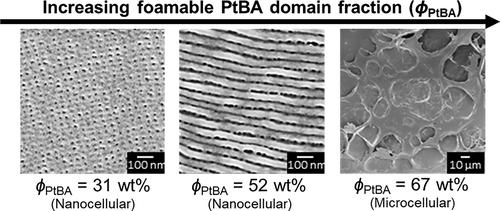当前位置:
X-MOL 学术
›
Macromolecules
›
论文详情
Our official English website, www.x-mol.net, welcomes your
feedback! (Note: you will need to create a separate account there.)
Control of the Cell Structure of UV-Induced Chemically Blown Nanocellular Foams by Self-Assembled Block Copolymer Morphology
Macromolecules ( IF 5.1 ) Pub Date : 2022-06-08 , DOI: 10.1021/acs.macromol.1c02332 Podchara Rattanakawin 1 , Kenji Yoshimoto 1 , Yuta Hikima 1 , Shinsuke Nagamine 1 , Yuhan Jiang 2 , Masatoshi Tosaka 2 , Shigeru Yamago 2 , Masahiro Ohshima 1
Macromolecules ( IF 5.1 ) Pub Date : 2022-06-08 , DOI: 10.1021/acs.macromol.1c02332 Podchara Rattanakawin 1 , Kenji Yoshimoto 1 , Yuta Hikima 1 , Shinsuke Nagamine 1 , Yuhan Jiang 2 , Masatoshi Tosaka 2 , Shigeru Yamago 2 , Masahiro Ohshima 1
Affiliation

|
A method to fabricate highly ordered nanocellular foam by incorporating the UV-induced chemical foaming technique with self-assembly of a block copolymer, poly(methyl methacrylate-block-tert-butyl acrylate) (PMMA-b-PtBA), was reported in our previous communication [Rattanakawin, P. ACS Macro Lett.2020, 9 (10), 1433–1438]. Cells with a size of a few tens of nanometers were successfully generated within the cylindrical PtBA-rich domains by heating the UV-irradiated self-assembled PMMA-b-PtBA. Here, we show how other self-assembled morphologies of PMMA-b-PtBA, such as lamellae and PMMA-rich cylinders, affect the formation of nanocellular foams. It is demonstrated that cells generated from the lamella templates are largely expandable compared to those from the cylindrical templates, mainly due to the increase in gas amount produced within the PtBA-rich domains. Meanwhile, the lamellar framework is no longer maintained and transformed into a microcellular structure when the foaming temperature is increased near the glass transition temperature of PMMA. We show that such a drastic change in cell structure may be mitigated by increasing the molecular weight of PMMA.
中文翻译:

通过自组装嵌段共聚物形态控制紫外诱导化学吹制纳米泡沫的细胞结构
一种通过将紫外线诱导的化学发泡技术与嵌段共聚物聚(甲基丙烯酸甲酯-嵌段-丙烯酸叔丁酯)(PMMA - b -PtBA)的自组装相结合来制造高度有序的纳米多孔泡沫的方法在我们的以前的通信 [Rattanakawin, P. ACS Macro Lett。2020 , 9 (10), 1433–1438]。通过加热紫外线照射的自组装 PMMA- b -PtBA,在富含 PtBA 的圆柱形域内成功生成了几十纳米大小的细胞。在这里,我们展示了 PMMA- b的其他自组装形态如何-PtBA,例如层状和富含 PMMA 的圆柱体,会影响纳米多孔泡沫的形成。结果表明,与圆柱形模板相比,由薄片模板产生的细胞在很大程度上是可膨胀的,这主要是由于在富含 PtBA 的域内产生的气体量增加。同时,当发泡温度升高到接近PMMA的玻璃化转变温度时,层状骨架不再保持并转变成微孔结构。我们表明,可以通过增加 PMMA 的分子量来减轻细胞结构的这种剧烈变化。
更新日期:2022-06-08
中文翻译:

通过自组装嵌段共聚物形态控制紫外诱导化学吹制纳米泡沫的细胞结构
一种通过将紫外线诱导的化学发泡技术与嵌段共聚物聚(甲基丙烯酸甲酯-嵌段-丙烯酸叔丁酯)(PMMA - b -PtBA)的自组装相结合来制造高度有序的纳米多孔泡沫的方法在我们的以前的通信 [Rattanakawin, P. ACS Macro Lett。2020 , 9 (10), 1433–1438]。通过加热紫外线照射的自组装 PMMA- b -PtBA,在富含 PtBA 的圆柱形域内成功生成了几十纳米大小的细胞。在这里,我们展示了 PMMA- b的其他自组装形态如何-PtBA,例如层状和富含 PMMA 的圆柱体,会影响纳米多孔泡沫的形成。结果表明,与圆柱形模板相比,由薄片模板产生的细胞在很大程度上是可膨胀的,这主要是由于在富含 PtBA 的域内产生的气体量增加。同时,当发泡温度升高到接近PMMA的玻璃化转变温度时,层状骨架不再保持并转变成微孔结构。我们表明,可以通过增加 PMMA 的分子量来减轻细胞结构的这种剧烈变化。











































 京公网安备 11010802027423号
京公网安备 11010802027423号